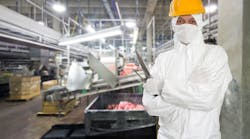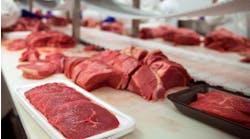In our April issue, we covered the impact coronavirus had on the entire food and beverage industry. As more details emerged and as the coronavirus crisis has continued, some patterns in the food industry are persisting. Some new – and troubling – patterns are emerging.
Probably the most ominous, on many levels, is the way the disease appears to have centered on the meat and poultry industry. Nearly all of the approximately two dozen deaths from COVID-19 reported among food processing workers so far have been in meat and poultry plants. About 20 plants have been shut down for at least a week, including the Tyson Foods plant in Waterloo, Iowa, its largest pork processing facility. Other closed plants belong to JBS, Sanderson Farms, Hormel Foods, National Beef and Smithfield Foods
The Smithfield plant in Sioux Falls, S.D., briefly became America’s biggest “hot spot” for the coronavirus, after testing revealed that about 16% of its 3,700 employees tested positive. The plant is now shut down indefinitely.
In some ways, the situation at meat and poultry plants is a reflection of unavoidable conditions. The biggest contributing factor is that most plants, especially slaughter plants, have workers standing shoulder to shoulder, inches apart; there is no other way to maintain what is considered necessary levels of throughput.
“It is not going to be easy to get workers six feet apart,” William Schaffner, a professor of infectious diseases at Vanderbilt University’s medical school, told the New York Times. “If you space people out, you reduce productivity.”
Spacing people out is especially difficult in meat processing plants, which are designed to break down animal carcasses one cut at a time, with each cut usually performed by a different worker. A poultry plant, for instance, might assign a worker to slice wings off birds impaled on spikes on a fast-moving conveyor belt. The only practical way to space workers out would be to slow the belt below what most companies would consider a viable level of throughput.
“They were constructed to have people stand next to each other and work, and that's very difficult to change,” Jim Roth, director of the Center for Food Security and Public Health at Iowa State University, told the Daily Mail.
Safety measures
Meat and poultry processors are trying to institute what safety measures they can. They have the basic problem as all other food processing facilities: Antimicrobial cleaning and safety measures are designed to guard against the risk of product contamination resulting in foodborne illness. Worker-to-worker transmission of illness is not something they are set up to handle.
“I believe a pandemic of this magnitude is once-in-a-lifetime event, and it is very challenging, if not impossible, to prepare in advance,” says Ravi Jadeja, an assistant professor and food safety specialist at Oklahoma State University.
Jadeja listed steps that are reasonable to expect plants to take (and that many are already taking), including:
- Taking the temperature of each incoming employee at the beginning of the shift
- Asking employees to disclose if they or any family members are sick or have traveled out of state in the past 14 days
- When it is not possible to maintain physical distance, using barriers of Plexiglas or similar material to separate employees
- Training about the importance of hand washing and other sanitation measures
- Hiring employees specifically to help with enhanced cleaning and sanitation practices
Critics cry foul
However, a number of critics are claiming that the meat processing industry has not done enough to stop the spread of coronavirus.
“I think it’s really clear that the reason so many workers in meatpacking plants are getting ill and dying is that the industry did not implement, weeks ago, the very comprehensive guidance issued by the Centers for Disease Control on how to prevent the spread of this disease,” says Deborah Berkowitz, safety program director for the National Employment Law Project and a senior policy advisor and chief of staff at OSHA from 2009 to 2015.
Berkowitz charges that the meat industry is suffering high rates of COVID-19 infection because it simply doesn’t prioritize safety.
“This did not have to happen. This is not inevitable,” she says. “It’s not in all [categories], and that’s because other [categories] in food processing separated workers.” She acknowledges that separation would cause a slowdown in production, but notes that “all businesses are slowing down production. And those businesses that don’t slow them down, many of them are closed.”
Unions that represent meat plant workers are also becoming increasingly critical, accusing the industry of not protecting its employees. “To know you’re coming face to face with something that has the potential of killing you or your family members, and then still going and doing your job — it’s a stressful situation,” Dan Clay of the Local 555 United, Food and Commercial Workers Union told KOIN-TV in Portland, Ore.
The meat dilemma
The coronavirus situation has the meat industry in a dilemma. Complying with directives and keeping employees safe means closing down plants – but doing so leads to dire consequences, not just for companies’ bottom lines, but for the nation’s meat supply.
John Tyson, chairman of Tyson Foods, took out full-page ads in newspapers April 26 warning that “the food supply chain is breaking” and that farmers will have to destroy “millions of animals.” Farmers reported having to euthanize piglets and egg-laying chickens, due to a lack of markets. A JBS USA plant in Worthington, Minn., which had been shut down April 20 due to coronavirus infections in its workforce, was reopened with a skeleton staff about 10 days later solely for the purpose of euthanizing and discarding hogs that couldn’t be processed.
President Trump took the debate to a new level on April 28 with an executive order under the Defense Production Act forbidding states to close meat and poultry plants (although they could close by the company’s own choice). The action protects meat processors from liability if employees contract COVID as a result of returning to work.
“We’re working with Tyson ... We’re going to sign an executive order today, I believe, and that will solve any liability problems where they had certain liability problems,” Reuters quoted the president.
Some observers have suggested that one reason for the high coronavirus case tally in the meat industry is simply the intensified level of testing.
“I don’t think the meat facilities have a disproportionate rate. I think they are essentially being targeted for testing as rural areas fear they are a disproportionate source that threatens the surrounding area,” says Edward Rodden, CEO of Wingate Packaging and a former executive with SugarCreek, a manufacturer of bacon and other foods. “They have deaths that you might not see in smaller facilities because they are so large in numbers of people, but I don’t think the death rate is disproportional either.”
Other sectors
Meat arguably is the market segment hardest hit by the coronacrisis. Its effect on other products has been varied; the biggest factor appears to be where they’re ordinarily consumed.
With consumers eating most of their meals at home, restaurants and other away-from-home channels have been severely constricted, with many shuttered and many others confined to takeout and delivery. This has severely affected product lines designed for foodservice.
Probably the biggest hit has been taken by the dairy industry, on two fronts: liquid milk losing distribution through schools and other institutions, and cheese not being used as hamburger toppings and in other restaurant meals. The blows came on top of the long-term trend of consumers drinking less milk.
In April, some of the co-ops that dairy farmers normally sell to were forcing them to dump milk because it literally wouldn’t pay to have it picked up. The problem was one of distribution, not demand. Retail prices for liquid milk and cheese were as high, or even higher, than they had been, but production plants were not able to make the transition to retail packaging fast enough. Milk is especially inflexible in this regard because, unlike meat and other foods, it can’t be frozen or otherwise preserved during slack demand.
On the other hand, processors who furnish foods more likely to be consumed from home have been thriving. The situation has been especially fortuitous for companies that make center-store staples, which had been in a long-term decline as consumers switched preferences more to fresh foods. Companies that have seen sales and/or profit improvements include Kraft Heinz (organic sales up 6.2% for the most recent quarter over last year); Nestlé (North American and European sales up 4.3%); Mondelēz (North American sales up 19%); and Grupo Bimbo (up 10%).
An interesting example of a company with a foot in both channels is PepsiCo. Although its beverage sales were up for the quarter, sales by volume were down, which the company attributed to a loss of sales opportunities in restaurants, theaters, convenience stores, gas stations and other non-grocery venues. (Coca-Cola reported a 25% drop in global sales volume for the same reason.) But PepsiCo’s Frito-Lay snack unit showed a 6.8% rise in sales for the quarter.


